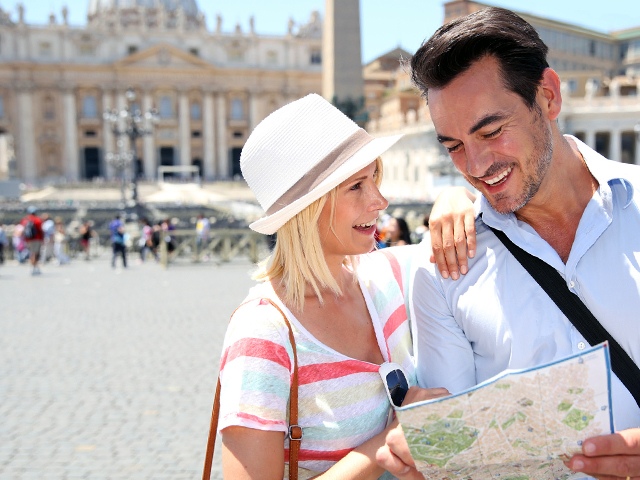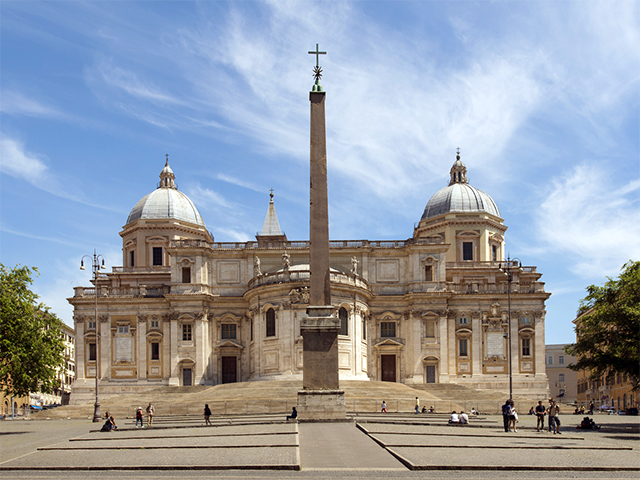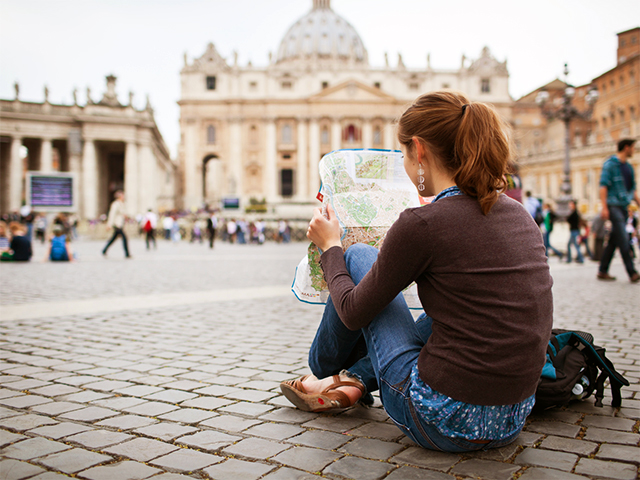Jubilee 2015: visiting the Seven Major Churches of Rome
Tour of the 7 Churches of Rome: an ancient pilgrimage to the discovery of the most beautiful churches.LENGTH

Two or more days
Difficulty

Difficult
Budget

Low
Route stops
- Basilica of St. Peter in the Vatican
Everything about the Basilica of St. Peter: history, art, the Pietà by Michelangelo, the dome and so many useful informations about opening hours, tickets and how to get there.
- Basilica of Saint Paul Outside the Walls
From the Tomb of the Saint to the portraits of the Popes. Here is what you can see in the Basilica of Saint Paul Outside the Walls: history, mass times and address.
- Basilica of Saint Sebastian outside the walls
Visiting the Basilica of Saint Sebastian outside the walls: catacumbs, opening hours, location and description of what to see in one of the Seven Pilgrim Churches of Rome.
- The Basilica of Saint John in the Lateran
What to see in the Basilica of Saint John in the Lateran in Roma: history, description, architecture and opening hours to visit Borromini's masterpiece
- Basilica of the Holy Cross in Jerusalem
Visiting the Basilica of of the Holy Cross in Jerusalem: opening hours and useful information to admire the sacred relics and the works housed in one of the Seven Pilgrim Churches of Rome.
- Basilica of Saint Lawrence outside the Walls
From the Courtyard of the Monastery to the cosmati-style mosaics, we are going to discover one of the Seven Churches of Rome: history, description and opening times.
- Basilica di Santa Maria Maggiore
Discovering the Papal Basilica of Santa Maria Maggiore: history, legend, description and opening times of one of the most beautiful churches of Rome
Everything about the Basilica of St. Peter: history, art, the Pietà by Michelangelo, the dome and so many useful informations about opening hours, tickets and how to get there.
From the Tomb of the Saint to the portraits of the Popes. Here is what you can see in the Basilica of Saint Paul Outside the Walls: history, mass times and address.
Visiting the Basilica of Saint Sebastian outside the walls: catacumbs, opening hours, location and description of what to see in one of the Seven Pilgrim Churches of Rome.
What to see in the Basilica of Saint John in the Lateran in Roma: history, description, architecture and opening hours to visit Borromini's masterpiece
Visiting the Basilica of of the Holy Cross in Jerusalem: opening hours and useful information to admire the sacred relics and the works housed in one of the Seven Pilgrim Churches of Rome.
From the Courtyard of the Monastery to the cosmati-style mosaics, we are going to discover one of the Seven Churches of Rome: history, description and opening times.
Discovering the Papal Basilica of Santa Maria Maggiore: history, legend, description and opening times of one of the most beautiful churches of Rome
The pilgrimage of the seven churches of Rome is an itinerary of about 20 kilometers that pilgrims used to cover in a single day, visiting the four patriarchal basilicas, in addition to the Basilica of Saint Lawrence outside the walls, The Basilica of the Holy Cross in Jerusalem and The Basilica of Saint Sebastian outside the walls.
If this old pilgrimage has lived on to the present day, it's due specially to Saint Philip Neri, who arrived at Rome in 1534 as a young priest who started travelling this itinerary spontaneously, first by himself and afterwards together with a few dozens of colleagues. He increasingly involved more people until getting to 6,000 participants, during the papacy of Pope Pius IV!
The pilgrimage, though, was not really invented by Saint Philip Neri. Actually, he refered to the very old Medieval tradition of pilgrims visiting the tombs of Saints Peter and Paul. Over the centuries, this tradition became a very important ritual for the faithful from all over the world, especially since the first great Jubilee established in the year 1300 by Pope Boniface VIII.
In the occasion of the extraordinary Jubilee of Mercy 2015, announced by Pope Francis, we present to you the complete itinerary.
TOUR OF THE SEVEN CHURCHES: WHEN?
We need to go back to 1552 for the pilgrimage to become a stable and organised custom. With the increasing participants' number, Philip Neri decided to dedicate a fixed day to the pilgrimage: on Holy Thursday. This is how the first official pilgrimage started on the 25 February 1552.
In the past, the route used to be covered in 2 days, starting on the previous Wednesday evening from the Church of Santa Maria in Vallicella and crossing the bridge Sant’Angelo towards St. Peter's. After the visit, the pilgrims used to stop by the Hospital of Santo Spirito in Sassia to pay a visit to the sick, before retaking the itinerary.
Today, on the other hand, the pilgrimage of the Seven Churches is usually travelled within 24 hours, twice a year: in September and in May, short before the Saint's Day, starting after the 7 pm Mass from Chiesa Nuova (Santa Maria in Vallicella) and arriving at 7 - 8 am the morning after to the Basilica of Santa Maria Maggiore.
This route is not only an proof of faith and devotion but also a way to discover the many artistic wonders kept in the most beautiful basilicas of Rome. So, let's put on a pair of comfortable shoes and let's discover all the stops of the route!
TOUR OF THE SEVEN CHURCHES: STOPS OF THE ROUTE
As previously mentioneD, the route starts right after the evening Mass at the Church of Santa Maria in Vallicella, located in the heart of Baroque Rome, in the square with the same name, in a widening of Corso Vittorio Emanuele II.
The first stop is the world's most important church: the Basilica of St. Peter. It's here, with the opening of the Holy Door, on the next 8 Decembre 2015 will start the Holy Year.
This basilica certainly needs no introduction: besides being the seat of the papacy, it is also a real container of artworks. In over a century many artists have worked on it, like Bramante, Raphael, Antonio da Sangallo the Younger, Michelangelo, Giacomo della Porta and Maderno. This stop generally ends with a visit to the Tombs of the Popes.
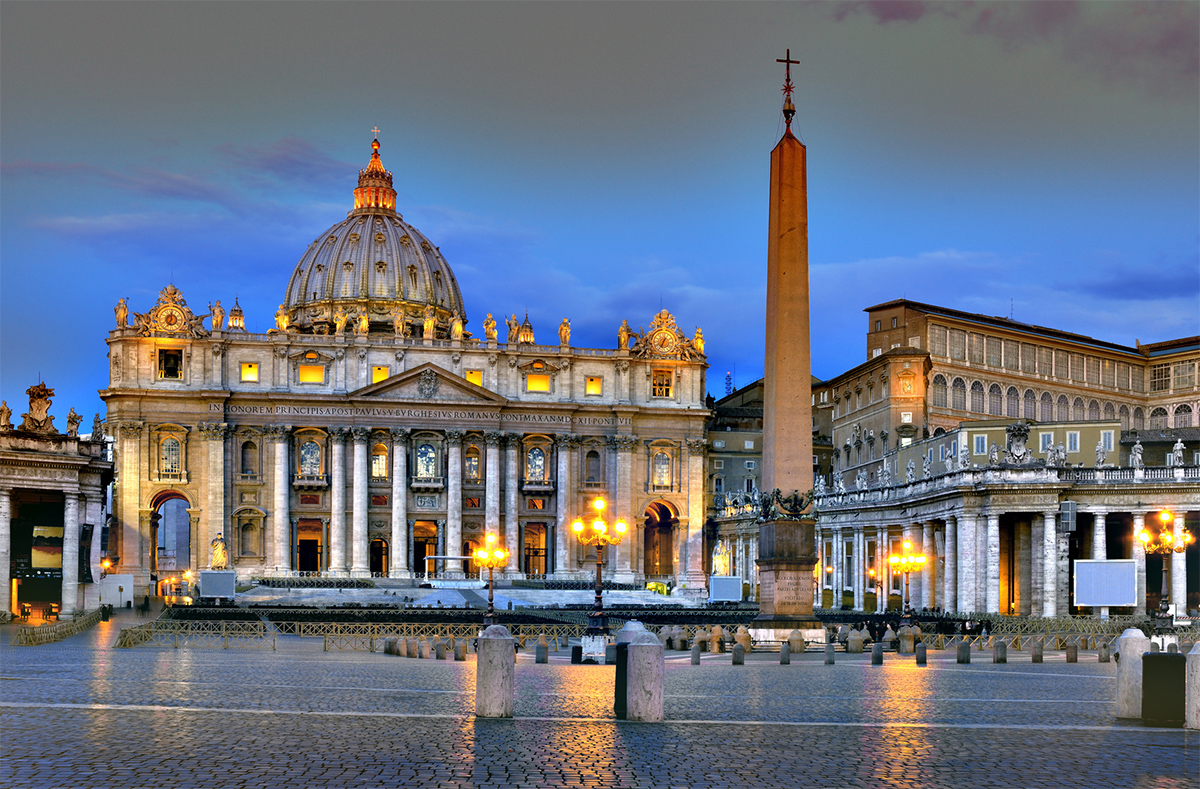
Basilica of St. Peter in the Vatican
From the Basilica of St. Peter, going along the Lungotevere until the junction with Viale Guglielmo Marconi, you will get to the second stop of the route: the Basilica of Saint Paul outside the Walls.
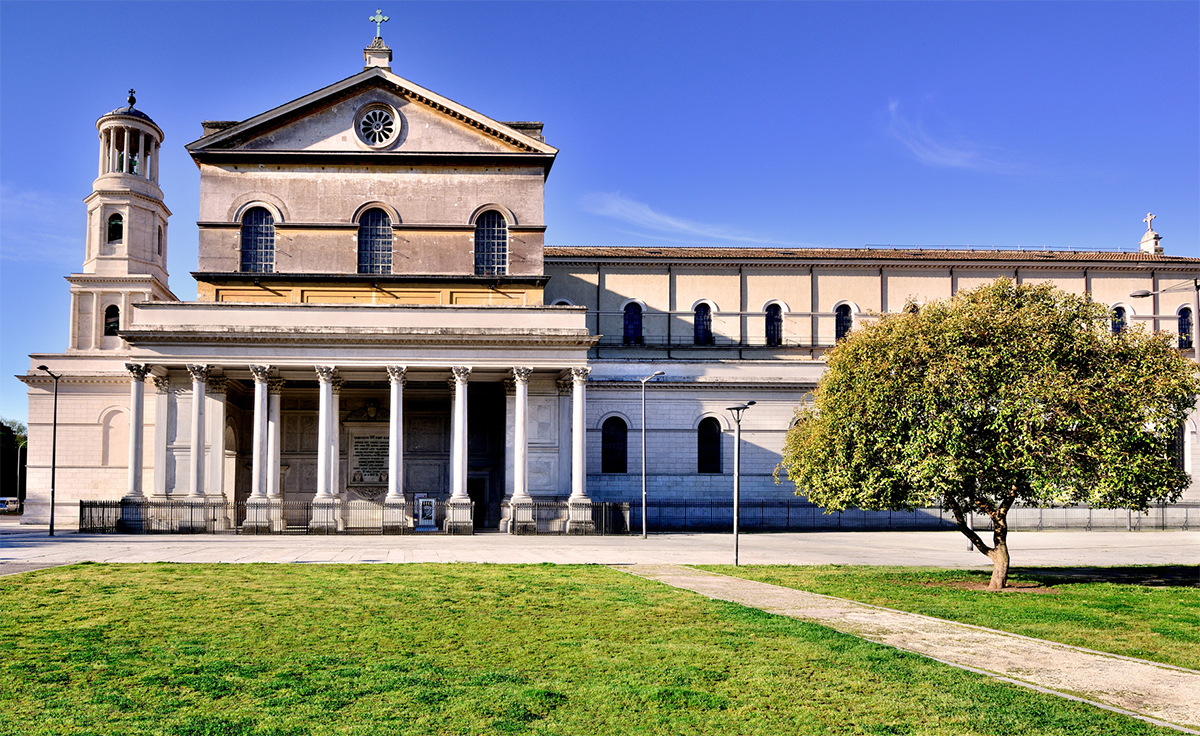
Basilica of Saint Paul outside the Walls
2. BASILICA OF SAINT PAUL OUTSIDE THE WALLS
The Basilica of Saint Paul outside the walls, placed along Via Ostiense, is the second stop of the pilgrimage. Built where Saul of Tarsus was buried, the basilica was destroyed in the fire of 1823 and rebuilt from 1826 thanks to the contributions of faithful from all around the world.
The quadriportico at the entrance leads you to one of the most majestic churches in Rome, famous for housing the portraits of all Popes, from Saint Peter to Pope Francis, in addition to a very beautiful courtyard and a precious Art Gallery.
From here, going along the street which is still called Via delle Sette Chiese (of the Seven Churches), you will reach the third stop, the Basilica of Saint Sebastian along the Via Appia Antica, between the Park of the Caffarella and the catacombs with the same name.
3. BASILICA OF SAINT SEBASTIAN OUTSIDE THE WALLS
Visiting the Catacombs of Saint Sebastian is an experience that will take you back in time, to the roots of Christianity. In addition, the Basilica of Saint Sebastian is really beautiful and houses several important archeological finds.
The interior of the church presents a wonderful carved wooden ceiling by Vasanzio with emblems of Cardinal Borghese and Pope Gregorius XVI.
The Chapel of Relics houses one of the arrows which martyred St. Sebastian and the stone imprinted with the footprints of Jesus of Domine quo vadis?
In the past it was customary to stop by Vigna Savelli, in the Park of the Caffarella.
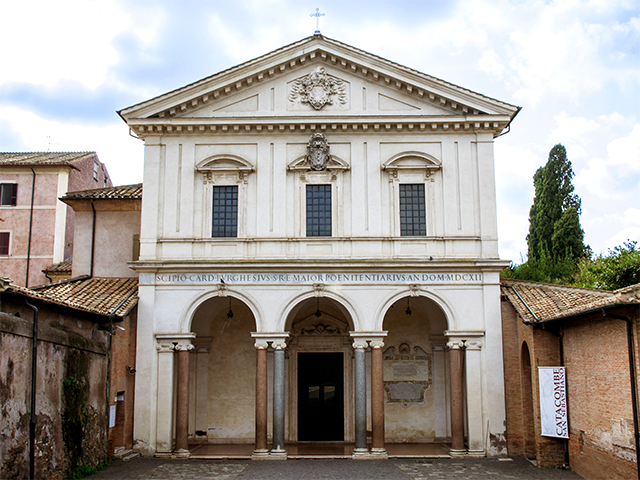
Basilica of Saint Sebastian outside the walls
Over the years, however, the custom became to stop by the Mattei Garden, which is today known as Villa Celimontana, before getting to the next stop, the Basilica of Saint John.

Basilica of Saint John in the Lateran
4. LA BASILICA DI SAN GIOVANNI IN LATERANO
The Basilica of Saint John in the Lateran, defined also as "mother of all churches" is part of a great monumental complex including the obelisk, the Lateran Palace and the Sanctuary of the Holy Stairs.
Considered one of Borromini's masterpieces, this splendid cathedral, established between 311 and 312 AD by Pope Miltiades, is located over the Celio Hill and it is beyond doubt an essencial destination for tourists and pilgrims from all over the world.
Among the works of art housed in the basilica is worth noting the famous fresco by Giotto representing Pope Boniface VIII announcing the first Jubilee in 1300.
Once outside the Basilica it is customary to visit also the Sanctuary of the Holy Stairs.
According to tradition, Saint Helene, mother of Constantine, during her pilmgrinage to the Holy Land had the staircase that Jesus climbed in his way to the Sanhedrin in front of Pontius Pilate, short before being crucified, dismantled and taken to Rome.
Today, the Stairs are composed by 28 steps that can only be climbed by faithful on their knees in sign of devotion.
5. BASILICA OF THE HOLY CROSS IN JERUSALEM
From Piazza San Giovanni, going along the tree-line avenue Viale Carlo Felice, you can easily reach the Basilica of the Holy Cross in Jerusalem.
The basilica is especially known because it houses important relics, in addition to important frescoes, mosaics and a copy of the Holy Shroud.
In the Chapel of Relics are preserved authentic pieces of the True Cross, part of the crown of thorns, a holy nail and the Titulus Crucis.
According to tradition the relics were brought by St. Helena herself after her trip to the Holy Land.
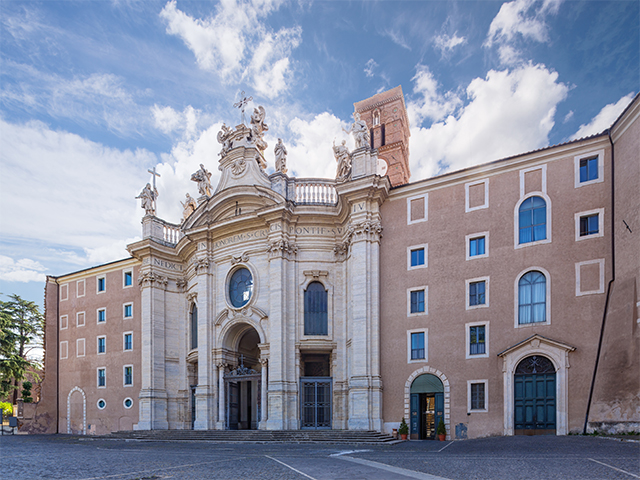
Basilica of the Holy Cross in Jerusalem
Once you exit the Basilica of the Holy Cross, through Porta Maggiore you will get to the Monumental Cementery of Verano, behind which is the Basilica of Saint Lawrence outside the Walls.

Basilica of Saint Lawrence Outside the Walls
6. BASILICA OF SAINT LAWRENCE OUTSIDE THE WALLS
Inside the Basilica is kept the Tomb of Saint Lawrence, martyred in 258 AD. under the empire of Valeriano, and the relics of Saint Stephen, together with other famous personalities like Italian Prime Minister Alcide De Gasperi and well five Popes: Saint Zosimo, Saint Sixtus III, Sant Hilarius, Damasus II and Pope Pius IX.
The church dates back to the 4th century and it was rebuilt after the bombings of 1943 using the original materials in order to keep its old architecture intact. Its distinctive trait lies in the fact that it is formed from the union of two churches: the first, Early Christian, commissioned by Constantine I, and the second designed two centuries after by Pope Pelagius II.
Once we exit the Basilica of Saint Lawrence we will head to the last stop of the pilgrimage, where the faithful usually ask for the Grace, the Basilica of Santa Maria Maggiore, enclosed between the square with the same name and Piazza dell'Esquilino a stone's thrown away from Termini Station.
7. BASILICA DI SANTA MARIA MAGGIORE
The Basilica di Santa Maria Maggiore is an absolute Early Christian masterpiece of art and architecture.
The Romanesque bell tower, 75 meters high is the highest bell tower in the city and it houses priceless mosaics, frescoes and sculptures.
The coffered ceiling gilded with gold is owed to Giuliano da Sangallo, while right to the Main Altar is the tomb of great architect Gian Lorenzo Bernini, the Relics of the Sacra Culla (Holy Crib), the 13th-century Nativity scene and the Baptistery.

Basilica di Santa Maria Maggiore
Here we are at the end of this wonderful itinerary of faith and cognition.
An old route that keeps involving millions of faithful. In view of the upcoming extraordinary Holy Year announced by Pope Francis, it will be the itinerary par excellence of all visitors in pilgrimage to Rome.



 PORT MOBILITY CIVITAVECCHIA
PORT MOBILITY CIVITAVECCHIA








